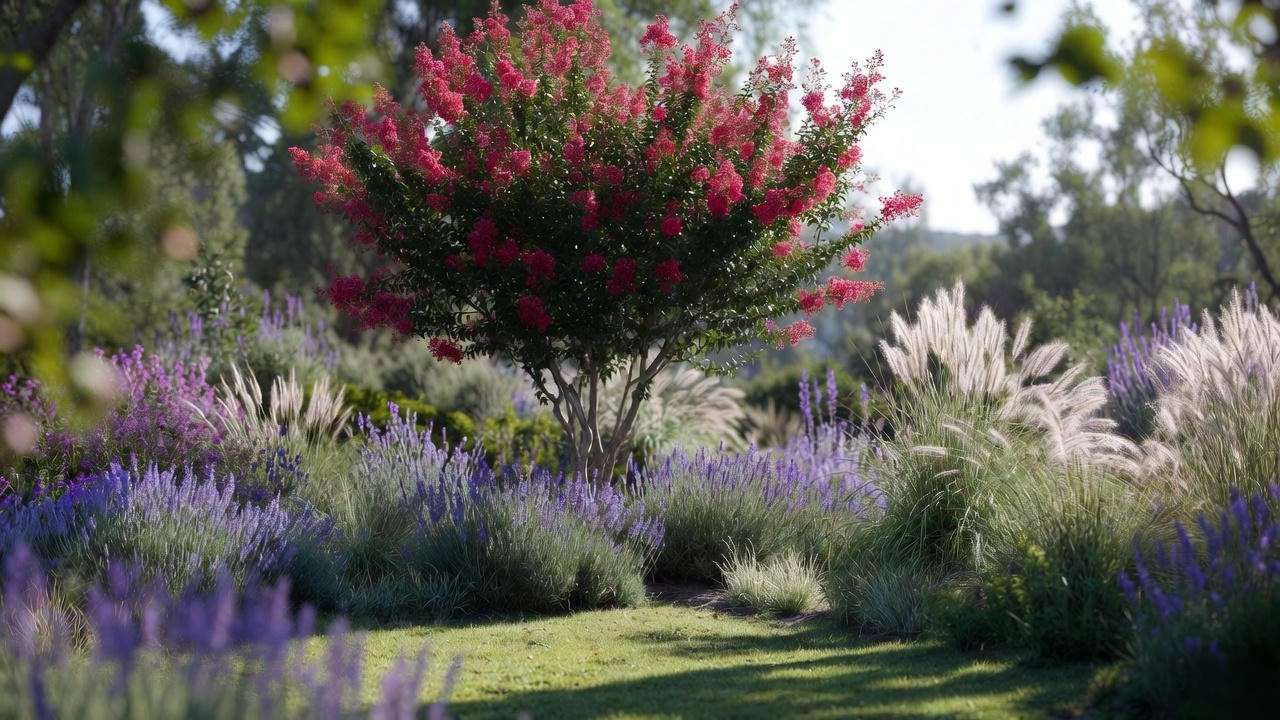Picture your garden ablaze with fiery red blooms, stealing the spotlight all summer long! The crape myrtle tree red is a breathtaking addition to any landscape, but its vibrant display demands a little know-how. Whether you’re a novice gardener or a seasoned pro, this guide reveals expert secrets to ensure your red crape myrtle thrives with stunning flowers and healthy growth year-round. From planting tips to pruning techniques, we’ve got you covered with practical advice to make your tree the envy of the neighborhood. Ready to transform your outdoor space? Let’s dive in! 😍
This comprehensive guide, crafted by a horticulture expert with over 15 years of experience in tree care and landscape design, draws on credible sources like university extensions and botanical gardens to deliver trustworthy, actionable insights. Expect everything you need to know about planting, caring for, and troubleshooting your red crape myrtle, plus design ideas to make it pop in your garden. 🌿
Why Choose a Crape Myrtle Tree Red? 🌟
The Allure of Red Crape Myrtle Varieties
Red crape myrtle trees are a gardener’s dream, combining bold color with easy care. Popular cultivars like ‘Dynamite,’ ‘Red Rocket,’ and ‘Tuscarora’ boast vivid red blooms that last from summer to early fall. Their peeling bark adds winter interest, while vibrant fall foliage in shades of orange and yellow extends their appeal. These trees are also drought-tolerant, pest-resistant, and adaptable to various climates (USDA Zones 6–9), making them a top choice for homeowners and landscapers alike.
Fun Fact: The ‘Dynamite’ cultivar can produce flower clusters up to 12 inches long, creating a fireworks-like display! 🎆

Ideal Uses in Landscaping
Red crape myrtles shine in multiple roles: as a standalone focal point, a privacy hedge, or even a container plant for patios. Their versatility makes them perfect for small yards or sprawling estates. Pair them with white-flowering shrubs like hydrangeas or low-growing perennials like lavender for a striking contrast. Expert Tip: Plant in groups of three for a dramatic effect in larger spaces. 🌼
Planting Your Red Crape Myrtle: Set the Stage for Success 🌱
Choosing the Right Location
To unlock the full potential of your crape myrtle tree red, location is key. These trees crave at least six hours of direct sunlight daily to produce their signature blooms. Choose a spot with well-draining, slightly acidic soil (pH 5.5–6.5). Avoid low-lying areas prone to waterlogging, as soggy roots can spell trouble. Consider the tree’s mature size—dwarf varieties like ‘Pocomoke’ stay under 5 feet, while ‘Red Rocket’ can reach 20–30 feet—so plan for ample space to grow.
Step-by-Step Planting Guide
- Timing: Plant in spring or early fall for optimal root establishment.
- Prepare the Soil: Loosen soil to a depth of 12–18 inches and amend with compost if needed.
- Dig the Hole: Make it twice as wide as the root ball but no deeper.
- Plant: Place the tree so the root flare sits just above ground level.
- Water and Mulch: Water thoroughly and apply 2–3 inches of organic mulch, keeping it away from the trunk.
Pro Insight: Planting too deep can suffocate roots, so double-check the root flare’s position! 🚫

Selecting a Healthy Tree
At nurseries or online retailers, look for trees with firm stems, vibrant leaves, and no signs of disease (like leaf spots or powdery coating). Container-grown trees establish faster, while bare-root options are budget-friendly but require extra care. Checklist: Ensure the roots are moist, the trunk is straight, and there’s no damage to the bark. A healthy start sets the stage for years of beauty. 🌳
Essential Care Tips for Vibrant Red Blooms 🌷
Watering Wisely
Newly planted red crape myrtles need consistent moisture—about 1 inch of water per week for the first year. Once established, their drought tolerance kicks in, and they’ll thrive with less frequent watering. Use a soaker hose or drip irrigation to deliver water directly to the roots. Overwatering can lead to root rot, so check soil moisture before watering. Tip: If leaves start wilting, it’s time to water deeply. 💧

Fertilizing for Maximum Growth
Feed your crape myrtle in early spring with a balanced fertilizer (10-10-10) or a low-nitrogen option to promote blooms over leafy growth. Apply according to package instructions, typically 1–2 pounds per 100 square feet. Avoid fertilizing late in the season, as it can spur growth vulnerable to frost. Common Mistake: Over-fertilizing can reduce blooms, so less is more! 🌸
Pruning Like a Pro ✂️
Pruning shapes your tree, encourages blooms, and removes dead or crossing branches. The best time is late winter or early spring before new growth begins. Follow these steps:
- Remove suckers at the base.
- Trim low branches for a tree-like form or leave them for a shrubby look.
- Cut back thin, weak branches to improve air circulation.
- Avoid “crape murder”—severe topping that weakens the tree and reduces blooms.
Myth-Busting: Contrary to old advice, heavy pruning isn’t necessary. Light, selective cuts maintain natural beauty and health. 🌿
Troubleshooting Common Red Crape Myrtle Problems 🐞
Pests and Diseases
While red crape myrtles are hardy, they can face a few challenges:
- Aphids: These sap-suckers cause sticky leaves and sooty mold. Control with insecticidal soap or neem oil.
- Powdery Mildew: A white coating on leaves, treatable with fungicides or improved air circulation.
- Cercospora Leaf Spot: Black spots leading to leaf drop; use resistant cultivars and remove fallen leaves.
Prevention Tip: Space trees properly and prune for airflow to minimize fungal issues. 🍃

Blooming Issues
If your crape myrtle isn’t blooming, consider these culprits:
- Too Much Shade: Relocate or thin surrounding plants.
- Improper Pruning: Avoid cutting flower buds in late-season pruning.
- Nutrient Imbalance: Test soil and adjust fertilization.
Case Study: A gardener in Texas revived their ‘Red Rocket’ by moving it to a sunnier spot and switching to a bloom-boosting fertilizer, resulting in a spectacular summer display! 🌞
Environmental Stress
Signs like wilting, yellowing, or stunted growth often point to stress from heat, drought, or poor soil. Mulch annually to regulate soil temperature and retain moisture. In extreme heat, provide supplemental water. If soil is compacted, aerate gently to improve root health. Expert Advice: A 3-inch layer of pine bark mulch works wonders! 🌱
Seasonal Care Calendar for Red Crape Myrtles 📅
Spring: Kickstart the Growing Season
- Fertilize: Apply a balanced fertilizer to fuel growth.
- Prune: Shape the tree and remove winter damage.
- Inspect: Check for pests or disease early.
Summer: Maintain the Show
- Water: Ensure 1 inch per week during dry spells.
- Deadhead: Remove spent blooms to encourage reblooming.
- Monitor: Watch for aphids or mildew.
Fall: Prepare for Dormancy
- Reduce Watering: Let the tree ease into dormancy.
- Clean Up: Rake fallen leaves to prevent fungal spread.
- Light Pruning: Trim for shape if needed.
Winter: Protect and Plan
- Winterize: In colder zones (6–7), wrap young trees in burlap.
- Plan: Research new companion plants for spring.
- Quick Tip: Mulch heavily to insulate roots in harsh winters. 🧣
Design Ideas: Make Your Red Crape Myrtle Pop! 🎨
Solo Star or Group Planting
A red crape myrtle tree can steal the show as a standalone specimen in your front yard, drawing eyes with its fiery blooms and graceful form. For larger spaces, consider planting in groups to create a vibrant hedge or a natural privacy screen. Space trees 6–15 feet apart, depending on the cultivar’s mature width, to allow room for growth without crowding. Design Tip: A single ‘Dynamite’ crape myrtle against a backdrop of evergreen shrubs creates a bold focal point that shines year-round. 🌟
Pairing with Other Plants
Red crape myrtles pair beautifully with plants that complement their vivid blooms and airy structure. Try these combinations:
- Ornamental Grasses: Switchgrass or fountain grass adds texture and softens the base.
- Lavender: Its purple flowers and fragrance enhance the summer display.
- Daylilies: Yellow or white varieties contrast with red blooms for a vibrant border.
Color Scheme Idea: Create a warm-toned garden by pairing your crape myrtle with orange zinnias and yellow coreopsis. For a cooler palette, add white hydrangeas and blue salvia. Inspiration: A Southern garden featuring ‘Red Rocket’ crape myrtles with drifts of white coneflowers was featured in Garden Design magazine for its timeless elegance! 🌼

Small-Space Solutions
Don’t have a big yard? Dwarf red crape myrtle varieties like ‘Pocomoke’ or ‘Chickasaw’ are perfect for patios, balconies, or small gardens, growing just 2–5 feet tall. When planting in containers, use a well-draining potting mix and ensure pots have drainage holes. Water regularly but avoid soggy soil. In winter, move potted trees to a sheltered spot or cover them in colder climates. Example: A gardener in Atlanta styled a ‘Pocomoke’ crape myrtle in a terracotta pot on their balcony, pairing it with trailing petunias for a stunning urban oasis. 🪴
FAQs About Red Crape Myrtle Trees ❓
Q1: How fast do red crape myrtles grow?
Red crape myrtles grow moderately fast, adding 1–2 feet per year under ideal conditions. Cultivars like ‘Red Rocket’ can reach 10–15 feet in 5–7 years, while dwarf varieties grow more slowly.
Q2: Can they survive in colder climates?
Yes, red crape myrtles thrive in USDA Zones 6–9. In Zone 6, choose cold-hardy cultivars like ‘Tuscarora’ and mulch heavily to protect roots. Wrapping young trees in burlap during harsh winters adds extra protection.
Q3: Why are my crape myrtle’s leaves turning black?
Black leaves often indicate Cercospora leaf spot, a fungal disease. Remove affected leaves, improve air circulation, and apply a fungicide if needed. Planting resistant varieties like ‘Dynamite’ reduces risk.
Q4: How do I propagate a red crape myrtle?
Propagate through softwood cuttings in late spring. Take 6-inch cuttings, dip in rooting hormone, and plant in a mix of perlite and peat. Keep moist and in bright, indirect light until roots form.
Q5: Are red crape myrtles deer-resistant?
Yes, crape myrtles are generally deer-resistant due to their tough leaves and bitter taste. However, hungry deer may nibble young trees, so use fencing or repellents in deer-heavy areas.
Note: For more details, revisit the relevant sections on care, troubleshooting, or planting! 🌿
Expert Resources and Further Reading 📚
To deepen your knowledge, explore these trusted resources:
- Books: The Crape Myrtle Handbook by the American Horticultural Society offers in-depth care advice.
- Websites: The University of Florida IFAS Extension (edis.ifas.ufl.edu) and Missouri Botanical Garden (missouribotanicalgarden.org) provide research-backed tips.
- Local Support: Contact your local cooperative extension service for region-specific guidance tailored to your climate and soil.
Bonus: Download our free Red Crape Myrtle Care Checklist from our website to keep your tree thriving year-round! Simply sign up for our plant care newsletter to access this exclusive resource. 🌳
Conclusion: Your Red Crape Myrtle Journey Starts Here! 🌈
With its dazzling red blooms, elegant form, and low-maintenance charm, the crape myrtle tree red is a must-have for any garden. By following this guide’s expert tips—choosing the right location, planting correctly, providing seasonal care, and troubleshooting issues—you’ll ensure your tree thrives with vibrant flowers and healthy growth. Whether you’re creating a showstopping focal point or a cozy patio display, your red crape myrtle will bring joy for years to come.
Ready to get started? Plant or care for your red crape myrtle today, using this roadmap to success. Share your crape myrtle photos in the comments below or join our plant care community for more tips and inspiration. With these secrets, your garden will be the talk of the town! 😍













